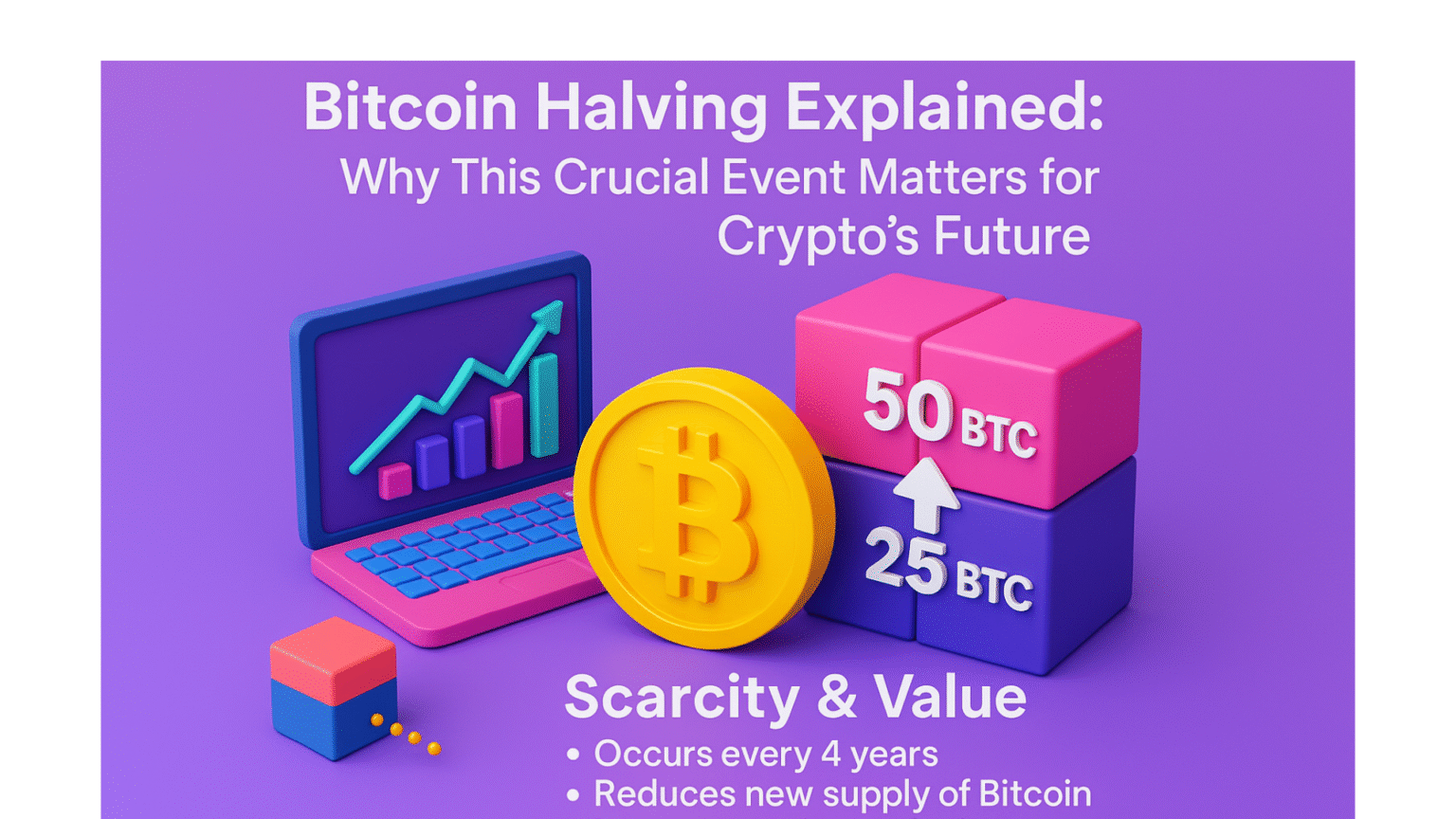Dive deep into the Bitcoin halving – what it is, why it’s vital for Bitcoin’s scarcity and value, and what historical and future impacts to expect. Understand this fundamental crypto event.
The world of cryptocurrency is a fascinating blend of cutting-edge technology, economic theory, and market dynamics. Amidst the rapid innovation, one event stands out as a fundamental pillar of Bitcoin’s design and a significant driver of its long-term value: the Bitcoin halving.
As we navigate through mid-2025, with the most recent halving having occurred in April 2024, the market is still digesting its full implications. Bitcoin’s price has seen substantial movements, and the underlying economics of its supply are more crucial than ever. Understanding the halving is not just for seasoned traders; it’s essential for anyone seeking to master the blockchain space and comprehend the very essence of digital scarcity.
This comprehensive guide from The Blockchain Mastery will demystify the Bitcoin halving, explore its profound significance, and delve into what it means for Bitcoin’s price, miners, network security, and the broader crypto ecosystem.
What Exactly is Bitcoin Halving? Decrypting the Core Concept
At its heart, the Bitcoin halving is a pre-programmed event within Bitcoin’s code that reduces the reward miners receive for validating new blocks by half. This isn’t a random occurrence; it’s a meticulously designed mechanism to control Bitcoin’s supply and ensure its scarcity.
The Genesis of Scarcity: How It Works
When Bitcoin was created by Satoshi Nakamoto in 2009, the reward for mining a new block was 50 Bitcoin (BTC). The protocol dictates that approximately every four years, or more precisely, every 210,000 blocks mined, this block reward is cut in half.
- Initial Reward (2009): 50 BTC per block
- 1st Halving (2012): Reduced to 25 BTC per block
- 2nd Halving (2016): Reduced to 12.5 BTC per block
- 3rd Halving (2020): Reduced to 6.25 BTC per block
- 4th Halving (April 2024): Reduced to 3.125 BTC per block
This systematic reduction means that the rate at which new Bitcoins enter circulation slows down significantly over time. It’s a fundamental aspect of Bitcoin’s deflationary monetary policy, designed to mimic the scarcity of precious metals like gold. The total supply of Bitcoin is capped at 21 million coins, a fixed limit that contrasts sharply with the inflationary nature of traditional fiat currencies, which can be printed indefinitely.
Why is the Halving Crucial for Bitcoin’s Economics?
The halving events are pivotal because they directly impact Bitcoin’s supply-demand dynamics. By reducing the “flow” of new Bitcoin, while demand theoretically remains constant or increases, the price tends to react. This mechanism is central to Bitcoin’s “hard money” properties and its appeal as a store of value. It ensures that Bitcoin becomes progressively scarcer, making it more valuable over the long term, much like gold’s limited supply drives its value.
Historical Impact: Lessons from Past Halving Cycles
Understanding the past can offer valuable insights into future possibilities, though it’s crucial to remember that past performance is not indicative of future results. Bitcoin has undergone four halvings to date, and each has left a distinct mark on the market.
The Post-Halving Price Surge Phenomenon
Historically, Bitcoin’s price has experienced significant rallies in the 12-18 months following a halving event.
- 2012 Halving: Bitcoin’s price surged from around $12 to over $1,100 in the year following the halving.
- 2016 Halving: The price increased from approximately $650 to nearly $20,000 by the end of 2017.
- 2020 Halving: Bitcoin saw a remarkable bull run, climbing from around $8,800 to an all-time high of nearly $69,000 by late 2021.
- 2024 Halving: While the immediate aftermath has shown some consolidation around the $60,000 – $70,000 range in the months following April 2024, the broader market consensus in mid-2025 is that the long-term bullish trend remains intact. Bitcoin’s price has recently surged past $109,000 (as of June 2025), indicating that the supply shock is beginning to manifest, albeit with a delay from previous cycles.
These rallies are often attributed to heightened demand meeting a sharply reduced supply, creating a powerful upward price pressure. The “Stock-to-Flow” (S2F) model, which quantifies scarcity, often aligns with these post-halving price surges, though its predictive power is debated in the short term.
Market Sentiment and Anticipation
Leading up to each halving, there’s typically a surge in market speculation and media attention. This “halving narrative” brings new investors into the space, contributing to increased demand and, often, pre-halving price appreciation. The excitement and discussions across crypto platforms generate a buzz that can act as a self-fulfilling prophecy.
Impact on Bitcoin Miners and Network Security
The halving significantly affects Bitcoin miners, who are the backbone of the network’s security.
The Profitability Challenge and Miner Adaptation
When the block reward halves, miners’ direct revenue from newly minted Bitcoin is cut in half. This can put pressure on less efficient or high-cost mining operations. In the aftermath of the April 2024 halving, we’ve observed a tightening of miner profitability, leading to:
- Increased Efficiency Drive: Miners are forced to upgrade to more energy-efficient ASIC (Application-Specific Integrated Circuit) hardware and seek out cheaper energy sources to maintain profitability. Regions with low electricity costs, like parts of the Middle East, Central Asia, and Africa, are becoming increasingly attractive for large-scale mining operations.
- Consolidation and Professionalization: Smaller, less capitalized miners may be forced out, leading to greater consolidation among larger, more professional mining firms. This creates a more robust and resilient mining industry in the long run.
- Reliance on Transaction Fees: As the block reward diminishes over successive halvings (the last Bitcoin is expected to be mined around 2140), miners will increasingly rely on transaction fees to secure their revenue. A healthy and active network with high transaction demand is crucial for miner profitability in the distant future.
Sustaining Network Security (Hash Rate)
Despite the profitability challenge, historical data shows that Bitcoin’s hash rate (the total computational power securing the network) has consistently rebounded and reached new all-time highs after each halving. This indicates the network remains incredibly secure. The “difficulty adjustment” mechanism in Bitcoin’s protocol ensures that as miners leave (or new, more efficient ones join), the difficulty of finding a new block adjusts, maintaining the approximately 10-minute block time and keeping the network robust.
This resilience underscores Bitcoin’s decentralized nature and its ability to adapt, ensuring that the network remains secure against potential attacks.
Broader Market Implications: Beyond Bitcoin’s Price
The ripple effects of the Bitcoin halving extend far beyond BTC itself, influencing the entire crypto market.
Altcoin Season Catalyst?
Often, a significant Bitcoin bull run triggered or amplified by a halving can lead to an “altcoin season.” As Bitcoin’s price rises, investors who made profits in BTC often look to diversify into promising altcoins, seeking higher percentage gains. This can trigger a surge across various altcoin sectors, from DeFi tokens to NFTs and new Layer 1s. The current market environment in mid-2025 shows nascent signs of this, with select altcoins experiencing strong momentum following Bitcoin’s recent surge past $100,000.
Reinforcing Bitcoin’s Store of Value Narrative
Each halving event reinforces Bitcoin’s core identity as a scarce, digitally sound money. In an era of increasing global inflation and economic uncertainty, Bitcoin’s predictable, disinflationary supply schedule makes it an increasingly attractive hedge against traditional currency devaluation. This narrative is gaining significant traction among institutional investors.
Attracting New Capital and Mainstream Attention
Halving events are major news. They spark discussions, create educational opportunities, and often bring a fresh wave of retail and institutional interest into the crypto space. The increased awareness can lead to greater adoption, liquidity, and investment in the broader blockchain ecosystem, including platforms for blockchain scalability and interoperability – areas of expertise at The Blockchain Mastery.
H2: The Future of Bitcoin Halving and Long-Term Implications
The halving mechanism is a cornerstone of Bitcoin’s long-term viability and unique economic model.
The Road to 2140: What Comes Next?
The next Bitcoin halving is estimated to occur around April 2028, at which point the block reward will drop to 1.5625 BTC. This process will continue until approximately the year 2140, when all 21 million Bitcoins will have been mined.
- Post-2140 Scenario: Once all Bitcoins are mined, miners’ revenue will rely entirely on transaction fees. This underscores the long-term importance of Bitcoin’s utility as a medium of exchange and a settlement layer, ensuring a robust and active transaction market.
- Deflationary Pressure: The continuous reduction in new supply solidifies Bitcoin’s deflationary nature, potentially leading to increased purchasing power over time if demand continues to grow.
Bitcoin’s Role in a Maturing Digital Economy
As the digital economy evolves, the halving events serve as periodic reminders of Bitcoin’s fixed supply and transparent monetary policy. This predictable scarcity contrasts with traditional monetary systems, making Bitcoin a unique asset in a world increasingly looking for alternative stores of value. Institutional adoption, particularly with the proliferation of Bitcoin ETFs, highlights its growing acceptance as a legitimate asset class. This trend is likely to accelerate as Bitcoin continues its journey towards full supply issuance.
Empowering Your Crypto Journey with Knowledge
Understanding the Bitcoin halving is more than just grasping a technical detail; it’s about comprehending a foundational principle of decentralized finance and digital economics. It’s a testament to the ingenious design of Bitcoin and its potential to revolutionize our financial future.
At The Blockchain Mastery, we believe that true mastery comes from deep understanding. Explore our courses on blockchain scalability and interoperability mastery and become a Certified Web3 Blockchain Developer (CW3BD)™ to gain further insights into the core technologies driving this revolution.
The halving is not merely a cyclical event; it’s a built-in economic reset, a proof-of-concept for digital scarcity, and a powerful force shaping the past, present, and future of Bitcoin and the wider cryptocurrency market.
bitcoinhalving, #bitcoin, #crypto, #cryptocurrency, #blockchain, #halvingexplained, #btchalving, #cryptomarket, #bitcoineconomics, #digitalgold, #scarcity, #web3, #defi, #cryptoinvesting, #cryptonews, #mining, #proofofwork, #theblockchainmastery

